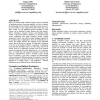Free Online Productivity Tools
i2Speak
i2Symbol
i2OCR
iTex2Img
iWeb2Print
iWeb2Shot
i2Type
iPdf2Split
iPdf2Merge
i2Bopomofo
i2Arabic
i2Style
i2Image
i2PDF
iLatex2Rtf
Sci2ools
CF
2004
ACM
2004
ACM
An architecture to support cooperating mobile embedded systems
There is a sustained trend to embed computer systems in all kinds of intelligent products. Increasing emphasis is given to enhance the functionality of such systems beyond the provision of easy-ofuse and comfort to more safety-critical tasks where they exert direct control over the intelligent product. Examples of such systems can be exploited in many domains like team robotics, factory automation, transport systems, and intelligent traffic control. To master the inherent complexity, we present a layered system architecture that partly integrates already existing components. It has to cope with two major challenges imposed by the considered type of applications. First, the architecture has to resolve the conflict between the autonomy of the individual systems and the demand to cooperate. We think that coordination is the key to the required effective cooperation. Coordination means that the individual systems can take actions under local control, based on a sufficiently consistent vie...
| Added | 20 Aug 2010 |
| Updated | 20 Aug 2010 |
| Type | Conference |
| Year | 2004 |
| Where | CF |
| Authors | Edgar Nett, Stefan Schemmer |
Comments (0)

